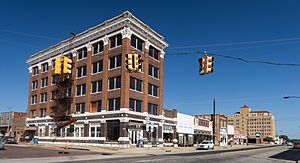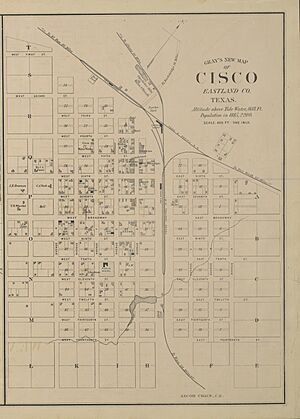Cisco, Texas facts for kids
Quick facts for kids
Cisco, Texas
|
|
|---|---|

Downtown Cisco (2024)
|
|
| Motto(s):
City of Progress
|
|

Location of Cisco, Texas
|
|
 |
|
| Country | United States |
| State | Texas |
| County | Eastland |
| Incorporated (city) | 1921 |
| Government | |
| • Type | Council-Manager |
| Area | |
| • Total | 4.96 sq mi (12.84 km2) |
| • Land | 4.96 sq mi (12.83 km2) |
| • Water | 0.00 sq mi (0.01 km2) |
| Elevation | 1,644 ft (501 m) |
| Population
(2020)
|
|
| • Total | 3,883 |
| • Estimate
(2024)
|
4,029 |
| • Density | 782.9/sq mi (302.41/km2) |
| Time zone | UTC-6 (Central (CST)) |
| • Summer (DST) | UTC-5 (CDT) |
| ZIP code |
76437
|
| Area code(s) | 254 |
| FIPS code | 48-15004 |
| GNIS feature ID | 2409463 |
Cisco is a city located in Eastland County, Texas, in the United States. In 2020, about 3,883 people lived there. It's a place with a rich history, from its early days as a railroad town to its role in the oil boom.
Contents
History of Cisco
Cisco's story began around 1878 or 1879. A minister named C. G. Stevens came to the area. He set up a post office and a church. He called this new settlement "Red Gap."
A few families already lived nearby. A store was also operating half a mile away. In 1881, two important railroads crossed paths near Red Gap. The people living in Red Gap decided to move their town to this new railroad crossing.
Many people consider May 17, 1881, to be Cisco's "birthday." This was the day the railroad tracks crossed. Three years later, the town was officially recognized. It was renamed "Cisco" after John J. Cisco. He was a financier from New York who helped build one of the railroads.
The railroads continued to help Cisco grow. They sold land to new settlers. Brochures called Cisco the "Gate City of the West." Railroad agents even advised farmers on what to plant.
In the 1880s, Cisco began to develop more. The first hotel was built and managed by Mrs. Haws. Mrs. J. D. Alexander brought the first "fancy goods" store to town. Religious groups met in the schoolhouse until they could build their own churches.
By 1892, Cisco was a busy community. It had two newspapers and a bank. The economy was based on trade, ranching, and fruit farming. There were also local resources like limestone, coal, and iron ore. The town had 56 businesses, including a broom factory.
Major Events in Cisco's Past
On April 28, 1893, a very strong F4 tornado hit Cisco. It went right through the business area. The tornado killed 28 people. It destroyed or badly damaged almost every building. The city hall, all churches, all schools, and about 500 homes were ruined.
A famous hotel chain started in Cisco. Conrad Hilton bought his first hotel here in 1919. He had come to buy a bank, but it was too expensive. So, he bought the Mobley Hotel instead. Today, the Mobley Hotel is a museum and community center.
In the 1920s, Cisco became a petroleum boomtown. This was like nearby towns such as Ranger. Even though Cisco played a smaller role in the oil boom, its population grew very fast. Some people thought it reached 15,000 residents. After the boom, Cisco got a city charter. It also built a new railroad station that cost $25,000.
The first meeting of the West Texas Historical Association was held in Cisco in 1925. This group studies the history of West Texas.
A famous event called the Santa Claus Bank Robbery happened in Cisco. It was on December 23, 1927. A man named Marshall Ratliff and his gang tried to rob the First National Bank. Today, an auto parts store is on the bank's old site. A historical sign marks the event.
On May 9, 2015, a large tornado hit just south of Cisco. It destroyed several homes. One person died, and another was badly hurt.
World's Largest Concrete Swimming Pool
In its early days, Cisco often didn't have enough water. In the 1920s, the Williamson Dam was built north of town. This created Lake Cisco. The dam was named after James Milton Williamson, a long-time mayor.
At the base of the dam, the world's largest concrete swimming pool was built. This amazing place had a two-story building with a skating rink upstairs. It also had a zoo, an amusement park with rides, and a park. Famous musicians like Bob Wills performed there. For many years, it was a huge attraction.
The pool closed in the 1970s. The empty skating rink building burned down a few years later. The dam itself was once open to visitors, but it is not anymore.
Geography of Cisco
Cisco is in the northwest part of Eastland County. Interstate 20 runs through the south side of the city. This highway goes west about 45 miles to Abilene. It goes east about 105 miles to Fort Worth.
U.S. Route 183 goes through the center of Cisco. It leads north about 28 miles to Breckenridge. It goes south about 49 miles to Brownwood. Texas State Highway 6 also passes through downtown. It goes east about 10 miles to Eastland, which is the county seat. It goes northwest about 33 miles to Albany. Texas State Highway 206 leaves Cisco to the southwest. It leads about 22 miles to Cross Plains.
The city covers about 4.96 square miles (12.8 square kilometers). A very small part of this area is water.
Population Changes in Cisco
| Historical population | |||
|---|---|---|---|
| Census | Pop. | %± | |
| 1890 | 1,063 | — | |
| 1900 | 1,514 | 42.4% | |
| 1910 | 2,410 | 59.2% | |
| 1920 | 7,422 | 208.0% | |
| 1930 | 6,027 | −18.8% | |
| 1940 | 4,868 | −19.2% | |
| 1950 | 5,230 | 7.4% | |
| 1960 | 4,499 | −14.0% | |
| 1970 | 4,160 | −7.5% | |
| 1980 | 4,517 | 8.6% | |
| 1990 | 3,813 | −15.6% | |
| 2000 | 3,851 | 1.0% | |
| 2010 | 3,899 | 1.2% | |
| 2020 | 3,883 | −0.4% | |
| U.S. Decennial Census | |||
As of the 2020 United States census, there were 3,883 people living in Cisco.
Education in Cisco
The Cisco Independent School District serves the city's students. The Cisco High School football team is called the Loboes. They won the 2A Division II championship game in 2013. This was their first championship win. The school colors are black and gold.
Cisco College is a two-year college. It was started in Cisco in 1940. It is one of two community colleges in Eastland County. The college mascot is the Wranglers. Their school colors are blue and white.
Famous People from Cisco
- Darrell "Dash" Crofts (born 1938) is a musician. He was part of the music duo Seals and Crofts.
- Jean Porter (1922–2018) was an actress.
- Leslie Turner (1899–1988) was an American animator. He was also the father of the famous Gerber Baby.
- Dan and Farris Wilks are businessmen in the oil industry.
- Stan Williams was an NFL football player.
Gallery
See also
 In Spanish: Cisco (Texas) para niños
In Spanish: Cisco (Texas) para niños














